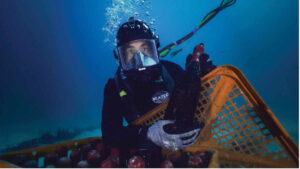Wild abalone ranches are starting to pay the bills; now OGA now wants to grow its own babies

Picture: Getty Images
WA shellfish farmer Ocean Grown Abalone (ASX: OGA) is cashed up and ready to expand its operations to a land-based facility.
The company turned its fortunes around to record an operating profit before tax of $1.1m in the first half of fiscal 2019 compared to a loss of $1.4m in the corresponding period the year before.
That was in part helped by a bigger harvest. Biomass increased by 48 tonnes to 211 tonnes, and an extra 80.4 tonnes of that was commercial grade abalone — about an extra $3m.
It’s total biomass value grew by 46.5 per cent to $8.6m in H1FY19, compared to $5.9m FY18.
Total sales were up 15 per cent to $1.7m for H1FY19 compared to $1.5m in H1FY18.
And costs were down. As the business moved from its construction phase to operating, diving, vessels and operating expenses fell by $341,801 and corporate and admin costs fell by $153,809 to $501,542.
All is looking rosy. So much so that OGA now wants to spend some cash on growing its own hatchlings onshore at a 34ha ranch on the outskirts of Esperance.
- Subscribe to our daily newsletter
- Bookmark this link for small cap news
- Join our small cap Facebook group
- Follow us on Facebook or Twitter
The Shire of Esperance Council has given in-principle agreement with OGA for the sale and development of the land — which it owns — 10km from the centre of town.
OGA wants its own hatchery and grow-out facility. It currently buys its young abalone from a hatchery in Bremer Bay, and transports them to around 413ha of reef network in Flinders Bay.
There the greenlip abalone are left to grow for three years on some 10,000 artificial “Abitats”, before being sold as “wild-harvested” produce.
While China produces an estimated 140,000 tonnes of farmed abalone per year, Australia leads the world in producing wild-harvested abalone — around 2400 tonnes per year.

OGA’s sales for the half year totalled 30,454kg whole in shell equivalent (WWE) of abalone product. Some 28,252kg of that was sold to customers in Asian markets.
The wild abalone fetch up to $US40 per kg, twice the average price of wholly farmed abalone.
That premium price is why OGA has developed it “ranching” operation.
“This opportunity provides a natural fit with our existing ocean ranching operations,” OGA managing director Brad Adams said.
“An OGA abalone hatchery and grow out facility will enable the company more control over the selection of juvenile abalone for seeding on the sea ranches and it’ll provide the ability to expand marketing opportunities and product lines.”
OGA has the option to lease the 34ha of land for $10,000 for 12 months, with another 12-month extension for $10,000 if required. It will also have exclusive rights to buy the land for $500,000 at any time during the two years of the lease offer.
The company also has the opening of a new seafood processing facility in June, which will bringing additional processing capacity for larger abalone harvest volumes, and potential value-add options through packaging, grading and increased capacity for live abalone exports.
UNLOCK INSIGHTS
Discover the untold stories of emerging ASX stocks.
Daily news and expert analysis, it's free to subscribe.
By proceeding, you confirm you understand that we handle personal information in accordance with our Privacy Policy.








